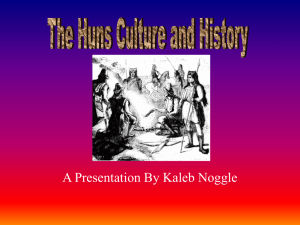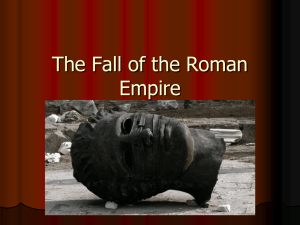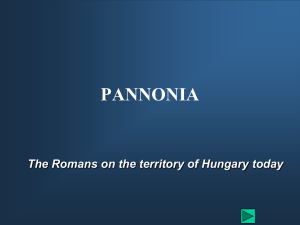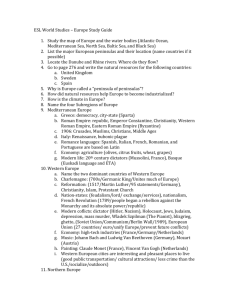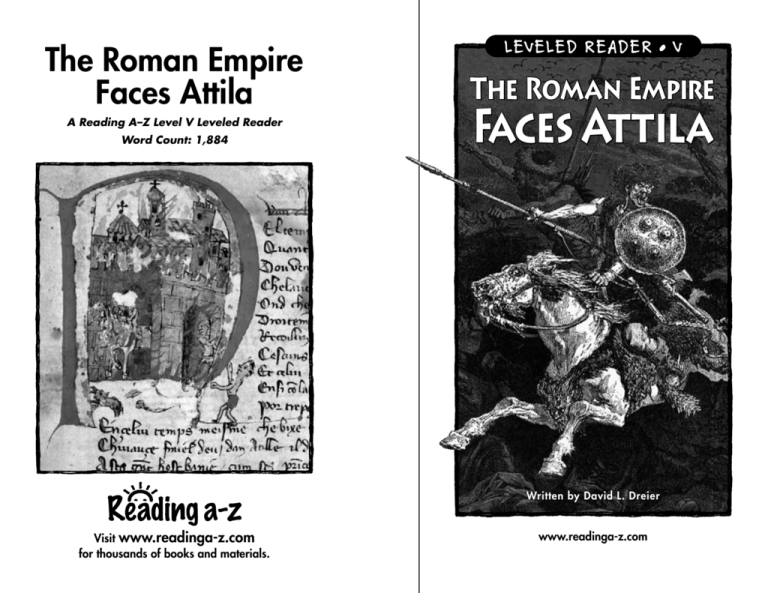
The Roman Empire
Faces Attila
A Reading A–Z Level V Leveled Reader
Word Count: 1,884
LEVELED READER • V
The Roman Empire
Faces At tila
Written by David L. Dreier
Visit www.readinga-z.com
for thousands of books and materials.
www.readinga-z.com
The Roman Empire
Faces Attila
Photo Credits:
Front cover: Royalty-free; back cover, page 17: © The Bridgeman Art Library;
© Alinari/Art Resource, NY; pages 5, 7: Adapted from Muir’s Historical Atlas:
Medieval and Modern, (London: 1911), Courtesy of The Internet Medieval
Sourcebook; title page, pages 4, 6, 9, 12, 18: © 2007 Jupiterimages
Corporation; page 8: The Granger Collection, New York; page 10: © Francoise
De Mulder/Roger Viollet/Getty Images; page 14: © Classic Image/Alamy; page
15: © Mary Evans Picture Library/Alamy; page 16: © Kean Collection/Hulton
Archive/Getty Images; page 19: © Attila Kisbenedek/AFP/Getty Images
The Roman Empire Faces Attila
Level V Leveled Reader
© Learning A–Z, Inc.
Written by David L. Dreier
Written by David L. Dreier
www.readinga-z.com
All rights reserved.
www.readinga-z.com
Correlation
LEVEL V
Fountas & Pinnell
Reading Recovery
DRA
R
25
40
Terror from Asia
Table of Contents
Terror from Asia . . . . . . . . . . . . . . . . . . . . . . . . . . . . 4
United We Stand. . . . . . . . . . . . . . . . . . . . . . . . . . . . 5
No invaders in ancient Europe struck as
much terror into people’s hearts as the Huns.
These ferocious horsemen from northcentral
Asia thundered into the heart of Europe in the
AD 370s. Wherever they went, they left death and
destruction behind them. Historians of the time
described the Huns as hideous barbarians who
killed without mercy.
The Scourge of God . . . . . . . . . . . . . . . . . . . . . . . . . 8
The leader of the
Huns when they
were at the height of
their reign of terror
was a man named
Attila (AT-uh-luh
or uh-TIL-uh). The
people of Europe
found Attila so
horrifying that they
called him “the
Scourge of God.”
Attila crushed
nearly every army
sent against him.
A Lady in Distress . . . . . . . . . . . . . . . . . . . . . . . . . 11
The Last of the Romans . . . . . . . . . . . . . . . . . . . . . 13
The Battle of Chalons . . . . . . . . . . . . . . . . . . . . . . . 14
Attila and the Pope . . . . . . . . . . . . . . . . . . . . . . . . 16
Divided They Fall. . . . . . . . . . . . . . . . . . . . . . . . . . 18
Glossary . . . . . . . . . . . . . . . . . . . . . . . . . . . . . . . . . . 20
Attila the Hun
3
4
In AD 376, a messenger brought some very
disturbing news to Roman Emperor Valens. The
messenger said that large numbers of Germanic
people called the Visigoths were swarming into
the Roman Empire. They were seeking protection
from a terrible new enemy from the east: the
Huns. This was the first time that the Roman
world had heard rumor of the Huns.
Roman Empire about AD 450
Franks
Ostrogoths
Danube River
Visigoths
Burgundians
Sueves
ATL ANTIC OCEAN
Western Roman Empire
Eastern Roman Empire
M E D IT
ERRAN
EAN S
EA
AFRICA
United We Stand
Beginning around 27 BC in Europe, the Roman
armies fanned out and conquered much of the
ancient world. The Roman Empire ruled as a
united entity for close to five centuries. By the
mid-300s, the empire was growing old and tired.
The empire covered so much land that it took two
emperors to govern it. One emperor ruled in the
west from the city of Rome; the other—Valens—
ruled in the east from Constantinople, a city in
what is now the country of Turkey. By the year 400,
the two halves of the empire would be permanently
divided and would never enjoy the power they had
once enjoyed as one united empire.
5
The Visigoth refugees were allowed to settle
in the Eastern Roman Empire. But the Romans
treated them
badly. The angry
Visigoths rebelled.
For two years, they
rampaged through
part of the Eastern
Empire, causing
great destruction
similar to what they
were fleeing. Valens
led an army to stop
the uprising, but the
Visigoths destroyed
his army and Valens
was killed.
Alaric I, king of the Visigoths, led his
people to rebel against those who
had given them shelter from the Huns.
6
The Scourge of God
Roman Empire about AD 526
Burgundians
The Huns had settled into an area that is now
part of the country of Hungary. They built towns.
The leaders lived in houses made of wood, but
most of the people lived in tents. The tents
enabled them to easily leave the settlement on
horseback, taking their home with them. The
Huns were not content with what they had. They
wanted more.
Franks
Danube River
Ostrogoths
Sueves
ATL ANTIC OCEAN
The Roman Empire
Visigoths
M E D IT
ERRAN
EAN S
EA
AFRICA
Nearly 100 years after the Visigoths sacked Rome, they and other
Germanic tribes had taken over the land once governed by the
Western Roman Empire.
Without the leadership of Valens, the Roman
Empire became weaker. The Visigoths and other
Germanic tribes began attacking the western part
of the empire. Without a central leader, the
Romans were powerless to stop the invaders.
Nearly 40 years after the Visigoths first started
fleeing the Huns, the Visigoths sacked the city of
Rome in AD 410. Enemies had not destroyed the
capital city in centuries. It was a devastating blow.
The last thing the Romans needed at this point
was even more trouble. But they were soon to get
it, and it came from the Huns.
7
The Huns wanted money and
nice things, so they attacked
people who had those things.
Beginning in the 420s, they
demanded an annual payment
of several hundred pounds of
Roman coin
gold each year from the Romans.
circa AD 440
Desiring to keep the peace, the
new Eastern Roman emperor,
Theodosius II (thee-uhDOH-shee-us) agreed to the
demand. For more than 20
years, the Huns accepted the
payments and caused the Romans
little trouble. That began to change in the AD 440s,
after a man named Attila rose to become the sole
ruler of the Huns and the Germanic people the
Huns had conquered.
8
Attila was in his late 30s. A Germanic historian
of the time described the new king: “[He has]
small, deep-set eyes,
a flat nose, a few
hairs in the place of
a beard, broad
shoulders, and a
short, square body.”
Other people who
met Attila said he
had very simple
tastes and ate and
participated in feasts
in moderation.
Attila might have
been moderate when
relaxing with friends,
but he was ferocious Attila during a feast with his
warriors
when dealing with
the Romans. He demanded more gold from
them. In order to maintain peace, Theodosius
agreed to double the annual payment, but then
Attila wanted even more. With an army of about
100,000 men, Attila launched war against the
eastern part of the Roman Empire. The Huns
reduced one Roman city after another to ruins
and killed many thousands of people.
9
Walls like these were built around the Eastern Roman Empire’s
capital, Constantinople, to keep invaders like Attila from taking
over the city.
To stop the destruction and killing, Theodosius
agreed to once again double the annual payment
of gold. The Huns would now get about 950
kilograms (2,100 pounds) of gold each year. But
when Theodosius died in AD 450, the new Eastern
Roman emperor, Marcian (MAR-shun), refused to
make any further payments. That put Attila into
a rage, and he took his fury out on the Western
Roman Empire.
10
A Lady in Distress
Historians theorize that Attila may have had
several reasons for turning his attention to the
western part of the empire. He may have decided
that Marcian was someone he didn’t want to anger.
Attila had also already drained the eastern part of
the empire of much of its wealth. Both of these
reasons made the Western Roman Empire an
inviting target.
Attila had never needed an excuse for attacking.
He just did it and took what he wanted. But this
time, he pretended that he had an excuse. Honoria
(ho-NOR-ee-uh), sister of the Western emperor,
Valentinian III, had written to him. Honoria had
been discovered having a secret romance with a
servant. The servant was executed, and Honoria
was locked away. Desperate to be free, she sent a
letter to Attila begging him for help. She enclosed
her ring as proof that she wrote the letter.
Attila announced that he considered Honoria’s
letter and ring a proposal of marriage. He said he
wanted to marry the young princess. As a dowry,
he demanded half of the Western Roman Empire.
Needless to say, Honoria’s brother Valentinian III
refused this demand. Attila then declared that he
would take what was rightfully his by force.
11
Attila really didn’t care about Honoria. It was
the Roman lands and riches he wanted. He was
determined to get them. He assembled an army
of about 100,000 men, including both Huns and
Germanic allies. In early 451, Attila and his army
crossed the Rhine River into Gaul—modern-day
France. For several months, the attackers sacked
and burned every city they conquered. They
killed men, women, and children without mercy.
They took people’s riches and all their food. Attila
believed that nothing
Attila’s territory
could stop him. He
N
was about to get a
Danube River
Roman Empire
big surprise.
Attila crossing the Danube, a river that helped define the northern
borders of the Roman Empire
12
The Last of the Romans
The Roman Empire was fortunate that it still
had one great general. His name was Flavius
Aetius (eye-EE-tee-us), and he served in the court
of Valentinian III. He is usually just called Aetius.
As the Western Empire crumbled, Aetius did all
he could to hold the
Thinking
empire together. For his
Critically
efforts, he has been
Aetius needed
remembered as “the Last
a larger army to
of the Romans.”
fight the Huns so
he convinced men
from Gaul to join the
Roman army. Which
is more important
when fighting an
enemy?
With the advance of
Attila through Gaul, Aetius
was facing the greatest test
of his life. He scrambled
to raise an army. Arguing
that Attila was the enemy
of humanity, Aetius
convinced some of the
Germanic tribes living
in Gaul to join forces with
him. These new allies
included a large force of
Visigoths under the command of their king,
Theodoric. Aetius’s army was now about as large
as Attila’s. In the late spring of 451, the Roman
general led his forces to fight Attila and the Huns.
Number
of men
or
talent?
13
The Visigoth king Theodoric was slain in battle with Attila and the
Huns, but Aetius and the Roman and Visigoth armies went on to
beat the Huns.
The Battle of Chalons
Aetius and his army caught up with Attila in late
June outside the city of Orleans, in modern-day
France. The Hun army had been conducting a
siege of the city. Seeing the approaching Roman
forces, Attila retreated toward an open plain near
the town of Chalons-sur-Marne. There, the two
huge armies met in one of the greatest battles
in history.
The Battle of Chalons began in the afternoon.
After firing arrows at each other, the two sides
fought up close with swords, spears, and axes.
By evening, when the fighting stopped, tens of
thousands of men from both sides lay dead on the
field. Among them was Theodoric. But there was
no question about who had won. Aetius’s army
had defeated Attila.
14
The next day, Aetius allowed Attila to retreat
with the remainder of his army. The Roman
general was criticized for this. But Aetius
probably made a wise decision. His strategy was
to keep the Germanic forces as allies of Rome.
The best way to do this was if the Goths and the
Romans had the Huns as a common enemy.
Attila’s army
withdrew from
Gaul, moving
back across the
Rhine River to
settlement. The
Western Roman
Empire was safe
for the time
being. But Attila
still had plenty
of men, and he
hadn’t given up
on conquering
the Western
Empire. The
Romans hadn’t
seen the last of
Attila and
the Huns.
Attila and the Pope
In June of the following year, Attila led his
army across the mountains into Italy. He was still
pretending that he wanted to marry Honoria.
The Huns so thoroughly destroyed
the city of Aquileia on their rampage
through Italy that the city never
recovered.
Attila and his armies were known for the
great violence they committed.
15
This time,
Aetius was unable
to raise an army
large enough to
fight the Huns. The
Germanic people
who had helped to
save Gaul were less
interested in saving
Italy. Attila’s army
roamed at will in
northern Italy,
demolishing
villages and killing
their inhabitants.
The army moved
closer and closer
toward Rome.
Aetius and Emperor Valentinian decided to try
diplomacy instead of battle. They asked Pope Leo I,
the head of the Catholic Church, for his help. They
wanted the pope to meet with Attila and ask him
to leave Italy.
16
Pope Leo met with Attila at the Huns’ camp.
What the two men said to each other was not
recorded. But Attila agreed to stop his attacks.
Danube River
AT L A N T I C O C E A N
This victory greatly increased the prestige of
the pope. However, some historians believe that
Attila was in a weaker position than many people
realized. They believe his army had not fully
recovered from the Battle of Chalons, and many
of his men were dying of a plague. In addition,
he was running short of food and other supplies.
Whatever Attila’s reasons were, he left Italy, never
to return.
Empire of Attila
about AD 450
Empire of Attila
EUROPE
AFRICA
M EDI TERRANEAN S EA
Divided They Fall
Attila stopped pretending to need Honoria as
a bride. In fact, he already had a number of wives.
In AD 453 he took a new bride, a beautiful young
woman named Ildico. After a day of feasting,
Attila and Ildico went to bed.
The next morning, Attila failed to emerge from
his bedroom. Worried servants entered his room
and found Ildico trembling with fear. On the bed
lay Attila. He was dead. During the night, the
king had suffered a burst blood vessel in his nose
or throat. He drowned to death on his own blood.
Pope Leo I kept Attila from furthering his attacks in Italy.
17
18
After the death of Attila, the Huns’ empire
did not last. His numerous sons split the empire
among themselves. Under Attila, the Huns had
been united, but now they became divided. Their
lack of unity caused them to grow weak.
Germanic tribes that had been ruled by Attila
saw that the Huns were weakening. In 454, they
revolted. Within a few years, they had overthrown
the Huns. With their empire shattered, the Huns
fled. In the words of one historian, they were
“scattered to the winds.” Once the terror of
humanity, the Huns made no more lasting marks
on history.
Glossary
allies (n.)
people or groups that join with others in
a common cause (p. 12)
barbarians (n.)
people from a foreign country who are
considered brutal or uncivilized (p. 4)
diplomacy (n.)
the practice of negotiating between leaders
of different countries (p. 16)
dowry (n.)
an amount of property or money given by
a bride’s family to the family into which
she marries (p. 11)
empire (n.)
a collection of nations or people ruled by
one person who has total authority (p. 5)
Germanic (adj.) describing a group of languages with
similar characteristics spoken across
northwestern Europe (p. 6)
humanity (n.)
all human beingsrace (p. 13)
prestige (n.)
a level of high standing or respect (p. 17)
rampaged (v.)
proceeded in a course of action in an angry
or violent way (p. 6)
sacked (v.)
destroyed a city and stole all its wealth
after capturing it from an enemy (p. 7)
scourge (n.)
a person or thing that is seen as an agent of
punishment, suffering, or vengeance (p. 4)
siege (n.)
surrounding and often attacking an enemy
for a long time while preventing them from
getting food and other supplies (p. 14)
More than 1,500 years after Attila’s reign, people in Hungary
asked the government there to officially recognize their
ethnicity as Hun.
19
20

